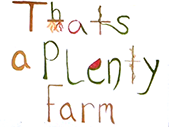

If you don’t use pesticides, aren’t you just inviting pests and diseases?
No.
Look at it this way: A healthy plant grows, bears fruit, does its thing. When it’s finished, it sends out a signal to the rest of Nature, saying, “I’m done here, time for me to go back to the soil. Come and help me do that.” And the “pests” and microbes whose purpose in Nature is to break down natural materials move in and begin the process of turning the plant back into soil.
These “pests” and microbes are not doing something bad, they’re doing what they are designed to do.
It’s when those pests and microbes come “too soon” that they are perceived as a problem.
Why do they come too soon? Because the plant is weak and IS beginning to die.
And if it’s dying too soon, that’s because the plant does not have all the nutrients it needs to thrive.
We can keep our plants thriving and reaching their full potential by making sure the nutrients and biological communities they need are available. Plants thrive when the soil thrives.
So…apply this perspective to human health. Disease moves in when our bodies don’t have the (literally) elements we need to thrive. Where do the elements come from? From our food. Where does our food get the elements? From the soil.
There is evidence all around the farm that the protocol we are following to increase Nutrient Density—increasing the strength and vitality of our plants by providing the appropriate biological and fungal conditions—is indeed working.
Strong cell walls mean “pests” won’t even perceive the healthy plant as a target, pests are attracted to the weak and vulnerable (it’s their job to help the dying break down). Most spectacular to us is the success of the 150 heirloom cherry tomato plants we hope will supply us with a commercial crop this year. In just the third week of harvest, we are yielding 50 pounds of ripe tomatoes daily. The stalks of the plants are mighty, the stems and leaves hairy, and the fruit is plentiful and luscious.
Our soil (Hadley loam) has been described to us as “the 8th best soil in the world.” Yet the soil tests show it lacks organic matter, most trace minerals, and has way too much salt, due to being farmed for 1000 years. The Nutrient Density protocol (as taught to us by Organic Farmer Dan Kittredge of the Real Food Campaign) has us adding trace minerals as well as biological and fungal inoculants.
Our tomato bed soil this year was obviously perfect as we raked it. On top of every 100 sq. ft. double-dug bed, we added: 2 lbs. Florastim, 3 lbs. Spring Blend, 1 lb. humates, 5 lbs Calcium Blend, 0.2 lbs. borax, 13 lbs. alfalfa meal, and 2-3 inches of organic compost. Then we have applied, weekly, foliar sprays and soil drenches.
Kittredge is guiding us along this new path. We have added his protocols for increasing Nutrient Density to the other farm practices, and the results this year are fantastic. STRONG plants, not many pests, increased crop yields. Kittredge is teaching a series of classes in New England; we encourage you to sign up!
